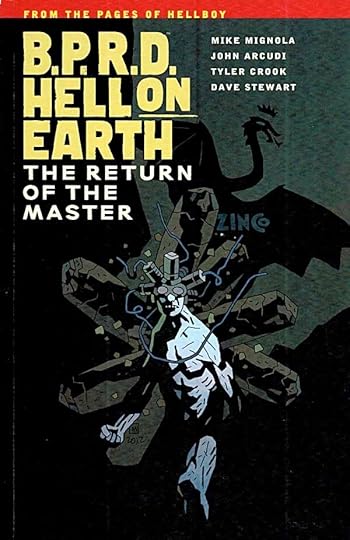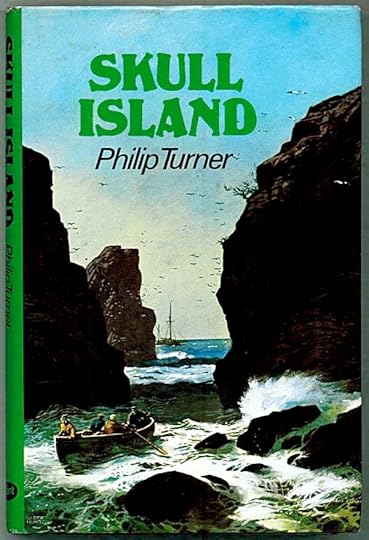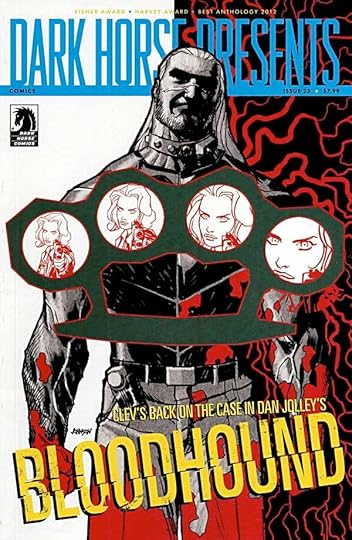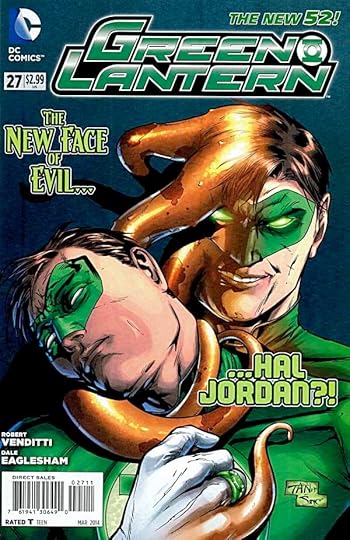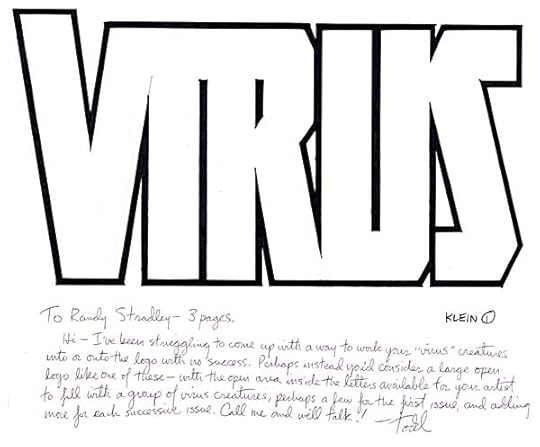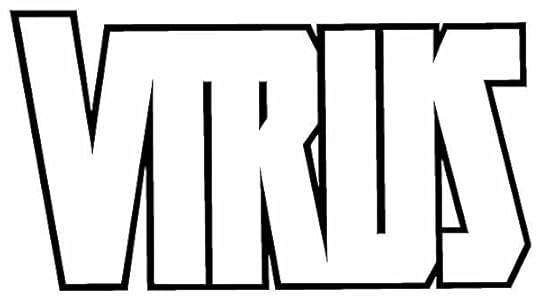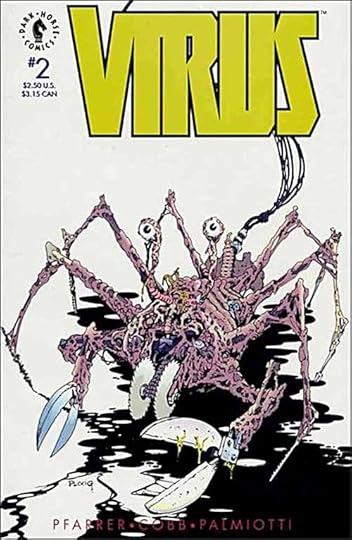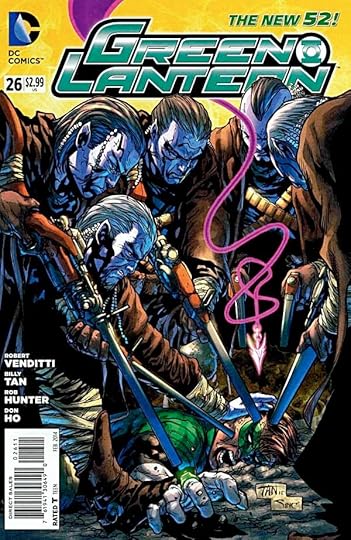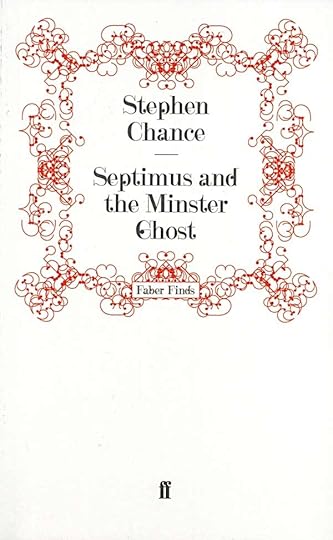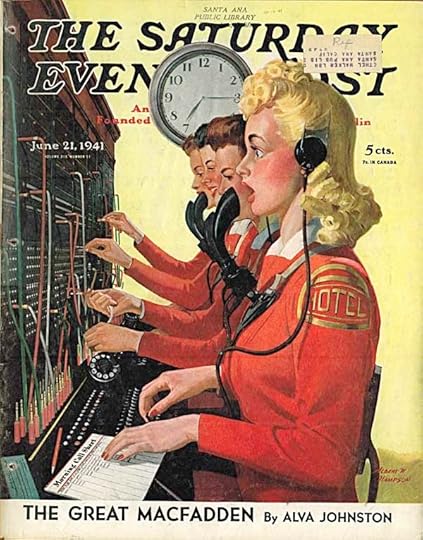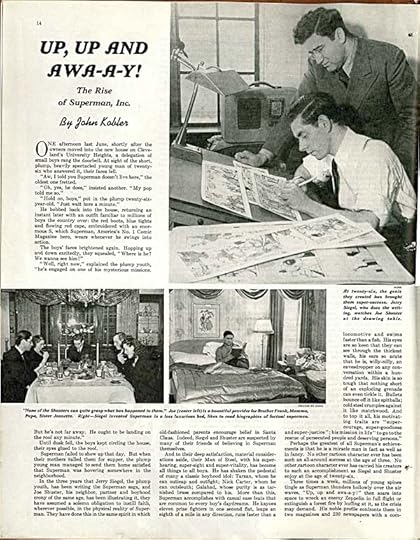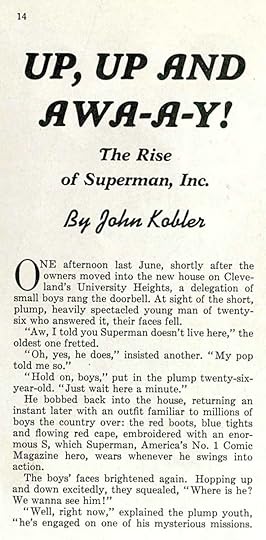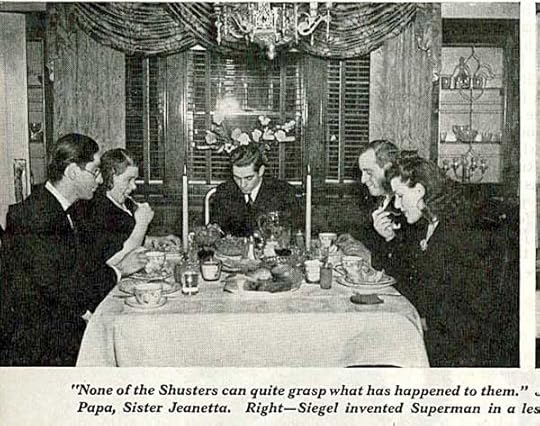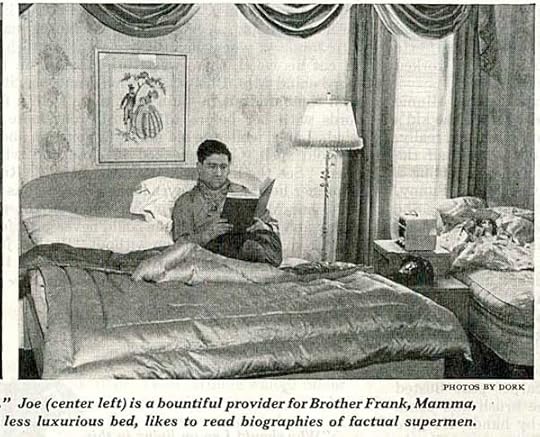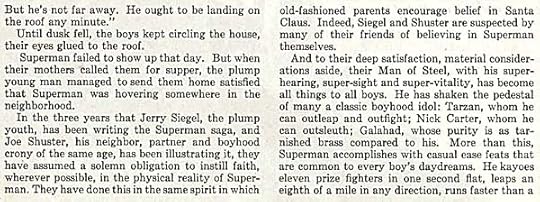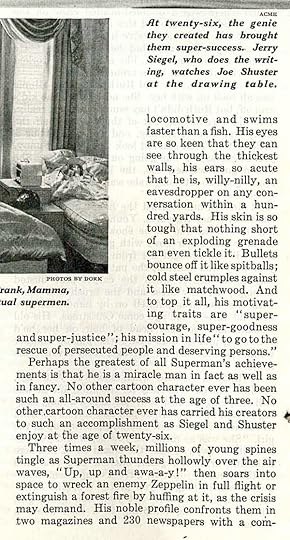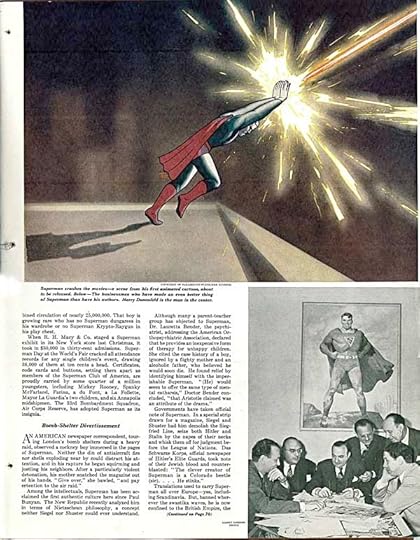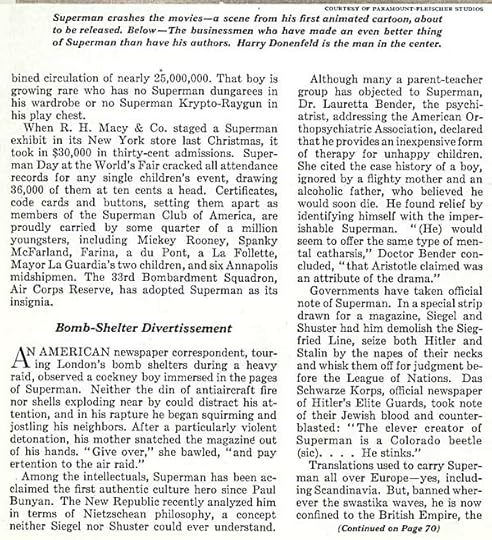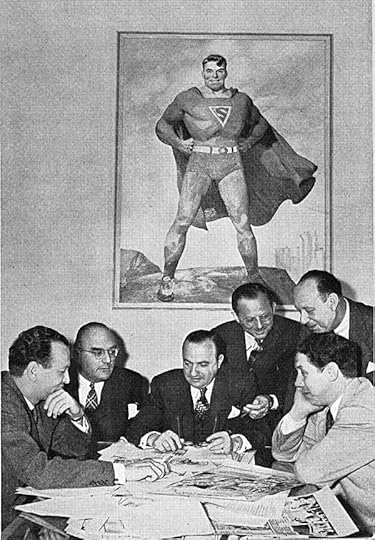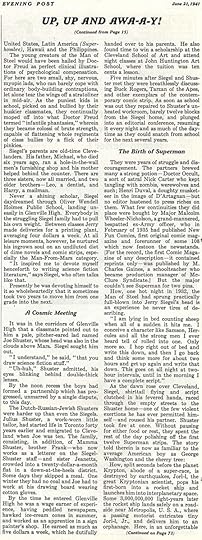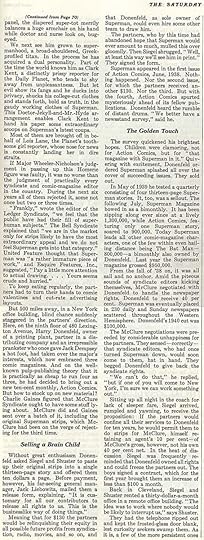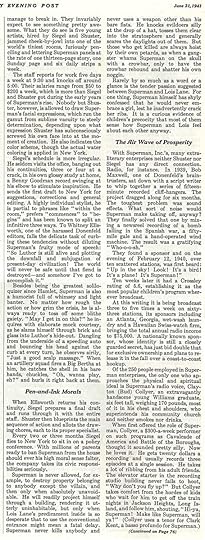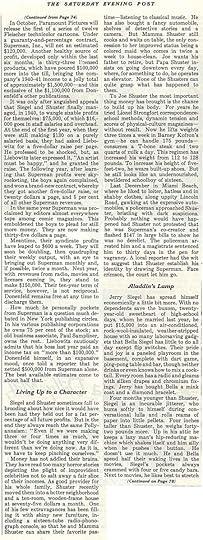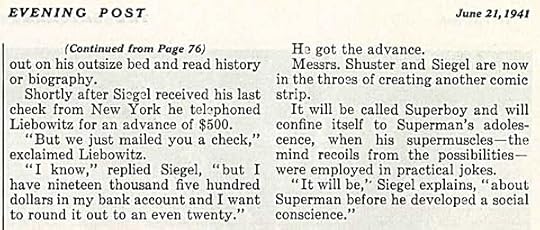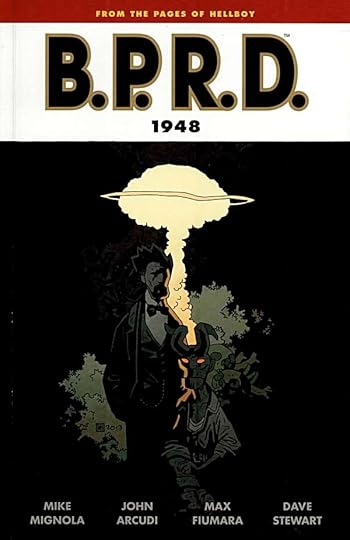Todd Klein's Blog, page 254
February 19, 2014
And Then I Read: B.P.R.D. Hell on Earth Vol. 6
Image © Mike Mignola.
Who would want to live in the world of B.P.R.D. and be a part of their team fighting supernatural menaces? No one in their right mind is the answer. Yet the psychodrama is compelling to me in a way that real-life crime, cruelty and corruption are not. As if the apparent end of the world is not enough for the team to deal with, a new threat has arrived in the form of a mad Russian with inexplicable and deadly powers. He shows up in Scotland and begins gathering acolytes. The B.P.R.D. goes on the attack, and as often happens, are not too successful. Meanwhile, back at headquarters the precognitive girl Fenix has shown up to apply for work with the Bureau. Things do not go well for her either. Various other plotlines, while quite interesting, can be summed up as “not going well for the B.P.R.D.” And it so rarely does. But the emotional and physical journeys of the characters are engrossing.
Recommended.
February 18, 2014
And Then I Read: SKULL ISLAND by Philip Turner
Image © estate of Philip Turner, cover illustration by Geoff Hunt.
I’m not sure when I discovered the series of books by Philip Turner about three friends in a small coastal town in England: Peter Beckford, clergyman’s son and mad scientist; David Hughes, carpenter’s son and the steady anchor, and Arthur Ramsgill; farmer’s son and daredevil. Their adventures stretch through their childhood, and this one, the last and the last I’ve found to read, has them in their late teens, just graduated from grammar school and about to face the challenges of university (or not). Reading this book was like revisiting old friends, even if the setting takes them far from home and their previous adventures.
The summer holidays are begun, and the three boys have been taken on as crew on a retired Thames barge captained by their old friend The Admiral, who is planning a long recreational voyage up the coast of Scotland to the northern islands beyond. The plan becomes more complicated and more meaningful when Peter’s Aunt Caroline arrives for a visit, and it turns out she and The Admiral are old friends. In fact, Aunt Caroline’s husband was a pilot who died in a crash while on a World War Two naval mission where The Admiral was also present. The crash occurred on a small, rocky, formidable island in the very area where The Admiral was charting his trip. Soon Aunt Caroline has been invited to join them, and an expedition is planned to try to find the wreckage and/or remains of the downed pilot. When they reach the island, it proves to be as difficult a place to get into and explore as one could imagine. The story of how they manage it and what they find there makes up the best part of the story.
Highly recommended, if you can find it. All Philip Turner’s books are excellent reading.
February 17, 2014
And Then I Read: DARK HORSE PRESENTS 23
Image © Dark Horse Comics.
I am really far behind on this title. The fact that it’s an anthology makes it easier to let it sit, and the length of each issue does not help. I must catch up! The cover feature begins a new arc for writer Dan Jolley’s quirky police detective series with art by Leonard Kirk and Robin Riggs. This time there’s been some murders, and all the victims had the same enemy. Trouble is, that enemy is dead. Or is he? Great start.
“Eden” is next, an excellent stand-alone story written by Jim Alexander, terrific art by John Higgins. Somehow reminds me of the stories Jan Strnad and Richard Corben used to do in the seventies.
“Journeymen” hasn’t done much for me yet, but takes an interesting turn on the final page of this chapter.
The first chapter of “Brain Boy” tries that very tricky thing, writing about a genius. This one also has psi-powers that make him a tool for anti-terrorist forces. Not bad writing by Fred Van Lente, nice art by Freddie Williams II.
“King’s Road,” another new series by Peter Hogan and Phil Winslade is an unusual mix of agents battling dark magic to protect a princess, but in a very mundane suburban setting. Intriguing.
“Beneath the Ice” by Simon Roy & Jason Wordie concludes. I enjoyed this arctic shaman adventure, even if I didn’t understand all of it.
“Gabe and the Sandpiper” is a standalone story by Pete Doree and Sean Phillips. An Indiana Jones sort of adventure on the Amazon with interesting twists and fine art.
“Villain House” by Shannon Wheeler continues to be entertaining and funny, a super-villain satire of sorts.
Best of the issue for me is the beginning of a new “Nexus” serial by Mike Baron and Steve Rude. This one seems to be about to team him up with Sherlock Holmes, which sounds like fun, if a little contrived. Love it anyway!
Recommended.
February 16, 2014
And Then I Read: GREEN LANTERN 27
Image © DC Comics, Inc.
Hal Jordan hasn’t been doing such a great job of running the Green Lantern Corps lately, but you can be sure that when he’s replaced by an evil alien lookalike, things aren’t going to improve. So far there hasn’t been much to surprise me in this storyline, but one nice surprise this issue is the art by Dale Eaglesham, pencils and inks. It looks great; realistic where needed and full of action, dramatic lighting and good character acting. He also keeps the layouts fresh with angled panels on every page. Nice work!
Recommended.
February 15, 2014
And Then I Read: THE SURPRISE MYSTERY by Wendell Farmer
Another novel written for children by Lavinia R. Davis under the pen name of Wendell Farmer and illustrated by Alice Harvey. This one is from 1943 and is more of a straight mystery story than the last one I reviewed here, “Bicycle Detectives,” which includes a wartime saboteur. It takes place in summer, in the idyllic small town of Penton Village, where young Roddy is hitching a long ride on a hay wagon, unknown to the driver, to a pond for a swim on a hot day. Getting home is not so easy, and he takes a shortcut through the property of Miss Amelia Blodgett, something of a hermit, with an infamous brother behind bars. Roddy sees some suspicious men sneaking away from the house, and the next day learns of a robbery at another nearby house. Were the men he saw the robbers? Roddy and his friends Skid and Tace decide to investigate, and the plot thickens when they see the same men hopping a freight train out of town. Could Miss Blodgett be involved? She’s acting suspicously, and there might be someone hiding in her house. But then, when Skid’s dog Bunce gets hit by a car right outside the Blodgett house, Miss Amelia comes to his rescue and helps save him. Later, the plot thickens when some other men are seen apparently harassing Miss Blodgett. Roddy and his gang are determined to find out the truth.
A good story, again not the best work of Davis, but worth reading if you can find it. It’s remarkable how, as soon as an animal is involved, the writing perks up. Davis is at her best then. But this is a fun read.
Recommended.
February 13, 2014
Pulled From My Files #21: VIRUS Logo
Images © Dark Horse Comics, Inc.
Sometimes when working on a logo you’re asked to do something that you can’t make work. That was the case with this assignment from Dark Horse editor Randy Stradley. He wanted the “virus” creatures from his story to appear somehow in the logo. Perhaps he was thinking of the original MAD logo where Harvey Kurtzman filled the centers of the letters with a crowd of crazy people. Unfortunately, I’m not that talented, so I suggested to Randy that I provide him with an open logo like this and perhaps his artist could add some of the creatures.
He must have agreed, and here’s a photocopy of the finished logo, simply a very tight and exact tracing of the sketch. except that I added a little space between the V and I so I could have that corner the same height as the ones to the right of it. I think it has strength and visual impact, and is easy to read even with the joined letters.
Apparently the creatures in the letters didn’t work for the artist either, or the idea was simply not followed, and the logo appeared as I designed it.
February 12, 2014
And Then I Read: GREEN LANTERN 26
Image © DC Comics, Inc.
Hal Jordan and some fellow Lanterns are on a mission to stop a Star Sapphire who’s also the leader of a planet full of hijackers and criminals. Hal seems to have lost a lot of the human insight and cleverness he showed during writer Geoff Johns’ tenure, and is becoming more like Guy Gardner to my eyes. While he’s been giving lip service to reducing the use of power rings, his trump card in this adventure (which seems an act of stubbornness more than anything) uses a huge amount of power. When he’s called on that, he doesn’t have a good answer. Hal used to be the smart one. If he still was, he might see what’s behind the trouble he keeps getting into. The art by Billy Tan with inking help from Rob Hunter and Don Ho is inconsistent; often it looks good, but in places the faces get strange. Not too distracting, but a little.
Mildly recommended.
February 11, 2014
And Then I Read: SEPTIMUS AND THE MINSTER GHOST by Stephen Chance
Philip Turner was an author of a fine series of novels written for children beginning with “Colonel Sheperton’s Clock,” reviewed in the link. Under the pen name Stephen Chance he also wrote four mysteries about country parson Septimus Treloar, formerly a Chief Inspector with Britain’s Criminal Investigation Department. These were also aimed at young adults, and are not actual murder mysteries. Most include supernatural elements, real or feigned, and as Turner was in the clergy himself, they’re full of realistic details about that aspect of the main character’s life. This was the only one I hadn’t read yet, all the Septimus books are now available from Faber Finds, the print-on-demand division of British publisher Faber and Faber, and now easy to find online.
This story takes place not in Septimus’s small country parish but in a larger neighboring town on the coast dominated by a massive minster (large church) which includes a lighthouse. A fanciful idea, but one the author has thought out in great detail, making the book all the more fun to read. A ghost has been seen late at night in the minster, or at least lights have been seen, and music played loudly on the organ, though no sign of a human player has been spotted by witnesses to the events, beginning with the Dean’s son Alistair. Septimus is called in by the Dean to investigate, and all kinds of fascinating architectural nooks and crannies in the minster and the town around it, not to mention a large cast of eccentric and entertaining characters, make a great setting for this novel. There are some hair-raising ghostly hauntings that seem to be the real thing, but Septimus is not convinced, and he soon sets about trying to trick and trap whoever is behind the supernatural happenings. There are a number of possible suspects, he soon finds, and plenty of danger for himself as well. And church officials are on his back to get some results once the press finds out about the hauntings.
Highly recommended, as are the entire works of Stephen Chance (and Philip Turner).
February 10, 2014
SUPERMAN IN THE SATURDAY EVENING POST June 21, 1941
Images © Curtis Publishing Company.
America first met Superman in the pages of ACTION COMICS #1 cover-dated June, 1938, after several years of development and failed attempts to sell it as a newspaper strip by creators Jerry Siegel and Joe Shuster. He revolutionized the the young comic book publishing market, and by 1941 was selling extremely well in ACTION, SUPERMAN and WORLD’S FINEST COMICS. I’m not sure how long it took journalists to start writing about the character, but an early, historic article appeared in this issue of THE SATURDAY EVENING POST, one of the most popular and important magazines of the time. Among other things, the article gave lots of attention to creators Siegel and Shuster, and included a photo taken in the office of publisher Harry Donenfeld that features the only known image of a famous Superman painting by H.J. Ward before it was revised by another artist. I wanted to read the article and see that original photo for myself for my own blog article about the painting, so I found a copy of the POST on eBay and bought it. Here’s the article in full with comments.
Pages 14-15 of the POST are a spread with photos and text, beginning the article, written by John Kobler, a reporter and journalist in New York City best known for a biography of Al Capone. Below are closer looks at each part of page 14 except the posed shot of Siegel and Shuster at a drawing board looking at some Superman comic strip art. The strip began in 1939, and the photo is probably a publicity shot taken to promote it.
The article begins in Cleveland, at the home of Jerry Siegel, in a story meant to show the popularity of the character with kids. Did Siegel really tell kids that Superman lived at his house and go through this charade? It sounds more like a made-up story, but perhaps I’m wrong.
This photo of the Shuster family at dinner is perhaps meant to show that they are living well on the success of Superman. The caption reads, “None of the Shusters can quite grasp what has happened to them.” Joe (center left) is a bountiful provider for Brother Frank, Mamma, Papa, Sister Jeanetta. So Joe is in the back, his brother Frank on the left.
Showing off even more luxury is Jerry Siegel in his bedroom. The rest of the caption reads, Right — Siegel invented Superman in a less luxurious bed, likes to read biographies of factual supermen. The POST reader is meant to quickly understand that Siegel and Shuster have reaped benefits from their character’s popularity.
Author Kobler explains the appeal of Superman to kids for his adult audience, and the idealistic attitudes of his creators.
Kobler is outlining a tale of the American dream realized by Siegel and Shuster. I’m pretty sure the “Up, up and awa-a-a-y!” line comes from either the Fleischer Superman cartoons or the Superman radio show rather than the comics, though. Note that Kobler has noticed only two titles publishing Superman, he must not have been aware of WORLD’S FINEST.
Page 15 of the magazine, the second half the the spread, is dominated by a color still from one of those Fleischer cartoons. The caption, below, says its the first one, and soon to be released. It hit theaters on Sept. 26, 1941. It’s interesting to note that there are no actual Superman comics shown in the article.
Kobler continues his success story with a list of facts and numbers relating to Superman sales and merchandising, as well as a list of prominent members of his fan club.
In the next topic, Kobler wants us to know Superman’s popularity extends to other countries of the world. He mentions an article in THE NEW REPUBLIC analyzing the philosophy of the character. At the bottom of the first column is the first of several unkind remarks about the creative pair by Kobler. He continues with comments from a psychiatrist at an address to a medical group that shows support for Superman, and suggests some parents are against the character. Continuing with international exposure, the comment from the official newspaper of Hitler’s Elite Guard is another slam at Siegel and his Jewish ancestry, if a rather odd and funny one.
Here’s that photo from Harry Donenfeld’s office with the Ward painting in the background (featuring the original triangular chest symbol and facial features). Left to right are Superman radio show producer Robert Maxwell, head of the company’s distribution arm Paul Sampliner, publisher Harry Donenfeld, his partner Jack Liebowitz, head of the sister company “All-American Comics” M.C. Gaines, and editor Whitney Ellsworth. I haven’t been able to identify what they’re looking at. Note the caption says, “the businessmen who have made an even better thing of Superman than have his authors.”
From here the article moves to the back of the magazine and the rest is all text, no photos.
Kobler continues to belittle and condescend to Siegel and Shuster on the beginning of this page. I have to wonder what they thought when they read it.
Under the next heading, Kobler tells of the original meeting of Siegel and Shuster leading to their partnership “unmarred by a single dispute.” He goes on with more about their families that is meant to make them seem poor and struggling, but also done in a condescending way. Of great interest to me is the description of Frank Shuster as a letterer on the Siegel-Shuster staff. This is the only mention of it I’ve seen, Frank is not in the Grand Comics Database or the Jerry Bails reference material. As a letterer myself, I’m happy to know who lettered at least some of the early Superman comics, perhaps all of them in 1941.
The article continues with hard times for the pair, early comic book sales to Major Malcolm Wheeler-Nicholson’s MORE FUN COMICS (the beginning of what’s now DC Comics), and trying to sell Superman. This continues into the Superman origin, where it’s interesting to see the Kryptonian name of the character’s father misspelled Jorl-l rather than the intended Jor-L, later to become Jor-El.
Under the heading “Selling a Brain Child,” Kobler gives us perhaps the earliest printed account of the transfer of ownership of Superman to the company that became DC Comics, a move instigated by Jack Liebowitz, according to this account. Kobler suggests the pair were desperate after seeing the character rejected repeatedly elsewhere, and that makes sense to me. The success it was soon having, with sales in the millions of copies, depicts Donenfeld and Liebowitz as the tough businessmen they were negotiating a later contract that was not much better, and the creative partners setting up their own shop in Cleveland with not much of the huge profits the character was making. Kobler’s attitude toward the publisher is becoming obvious.
Kobler describes the Shuster studio with five employees, which included Shuster himself and his brother Frank lettering. Artist Wayne Boring was probably another employee. Kobler then makes fun of Siegel’s prose style on the strip, while seeming to admire it in some ways. The moral policy is discussed: what Superman can and can’t do in his stories. Next he writes about the radio show. He states there are 250 people employed in Superman enterprises. I don’t know how he arrived at that, but it seems to include people working on the radio show, which was licensed by the publishers but not produced by them.
If Kobler didn’t have high opinions of Siegel and Shuster, the beginning of this page shows he probably thought even less of Donenfeld and the way he was treating the Superman creators. A lot of numbers are thrown around here that would be hard to verify, but the picture is clear he thinks the boys are being taken advantage of in a major way. On the other hand, Siegel and Shuster tell us how they’ve risen in the world with what they do get, able to provide for their families and buy lots of nice things. Kobler has some more fun with Siegel as a body-builder and big spender, Shuster as nervous and eccentric.
The final short section of the article seems to paint Siegel as unsatisfied with his finances, and talks about a new creation they’re working on, Superboy. The final line is an odd one. There’s no real wrap-up to this human interest piece, but there are lots of interesting things in it, and I certainly enjoyed reading it. As a snapshot of the lives of Superman’s creators in 1940 it’s invaluable.
Other articles that may interest you can be found on the COMICS CREATION page of my blog.
If you’d be interested in owning this issue of THE SATURDAY EVENING POST, now that I’ve scanned it I’ve put it back up on eBay HERE.
February 8, 2014
And Then I Read: B.P.R.D. 1948
Image © Mike Mignola.
While the main series featuring the government agency The Bureau for Paranormal Research and Defense is dealing with Hell on Earth in the present, this series is looking back at the youth of Hellboy and those around him. It’s a charming yet creepy look at the early years of the boy from Hell and his mentor (and protector) Professor Bruttenholm.
Atomic bomb tests are being done in the desert of the American southwest at the dawn of the atomic age, and somehow monsters are emerging from the test site and wreaking havoc. Are the bombs creating a rift in space-time to another dimension, or is it something else inherent in the artifacts of the explosions? Professor Bruttenholm investigates, bringing Hellboy and agent Anders along. Anders was involved in a recent deadly mission that left him possessed by evil powers, so he’s another wild card.
One of the test site scientists is the brilliant and beautiful Dr. Anna Rieu, who may have some ideas about those monsters. Agent Anders just wants to fight them, providing the action-filled sections of the book. Young Hellboy is almost a sideline character in this collection, but with a few important moments. The writing by Mike Mignola and John Arcudi kept me turning the pages, and the art by Max Fiumara, while a little too distorted in places, fits in well with the menacing, shadowy atmosphere of the Mignola franchise.
Recommended.
Todd Klein's Blog
- Todd Klein's profile
- 28 followers


